 This month we would like to cover some pretty key issues that too often get pushed into the background in the daily grind of financial nitty-gritty that the media prefers to highlight. Those reports are usually about economic events and other releases that are mostly of interest to day traders hop-ing to capitalize on the quick turns such reports cause. We present items below, in no particular order of im-portance, that caught our attention and that are of more interest to inves-tors with a longer term agenda.
This month we would like to cover some pretty key issues that too often get pushed into the background in the daily grind of financial nitty-gritty that the media prefers to highlight. Those reports are usually about economic events and other releases that are mostly of interest to day traders hop-ing to capitalize on the quick turns such reports cause. We present items below, in no particular order of im-portance, that caught our attention and that are of more interest to inves-tors with a longer term agenda.
Corporate Profits—This is clearly one of the most important factors that influence stock valuations yet it is rarely mentioned other than in pass-ing. Right now, and for some time, profits of public companies have been advancing regularly at rates above the historical average. In the past in these Letters, we have submit-ted that share prices track the growth in company profits pretty well. A chart reflecting profits and share pric-es together shows a close correlation, or at least did until about five years ago. We continue to be troubled by the departure of share prices from growth in profits since, and have spe-culated that hedge funds and the heavy increase in the use of deriva-tives in all matters financial at about that time might have had something to do with this. But the point we wish to make now is that with share prices beginning to move upward, there is every indication that the con-tinued climb in profits at a high rate fully substantiates and justifies the higher share price level. And, there is little ahead to suggest that company managements are likely to move away from closely monitoring quarterly profits against expectations within the financial community. The sophisti-cated nature of stockholders who own a majority of the outstanding shares of most public companies, virtually dic-tates that any management team whose members expect to keep their jobs must perform as expected profit-wise. The electronic world no longer allows unexplainable gaps in profitability for any major company. Because of this, corporate profits have become increa-singly predictable and widely known. This provides a strong base in support of the share prices for publicly traded companies.
Corporate Buybacks—Corporations have been buying back their own stock at record levels. As an example, Coke recently announced the largest share buyback program ever undertaken by that company. Reports indicated that the plan would remove close to 13% of the company’s out-standing shares over the life of the plan. What this means to investors is that even if Coke just holds its own in the soft drink market it dominates, those who hold its shares rather than sell them back to the company can ex-pect a 13% increase in the company’s share value simply by virtue of the fact that remaining shareholders will own a bigger piece of the pie afterward. This was not an unexpected Coke strategy move, in that we have long written of its high rate of profitability and strong cash flow, which if not distributed or spent on expansion, causes a reduction in its rate of return on capital. Please recall that today, stock prices are highly influenced by a company’s return on investment (ROI). Coke seems de-termined to get rid of its mounting cash hoard in order to avoid this kind of reduction in its ROI. In today’s 15% capital gains tax rate environment, it makes eminent sense for cash-rich com-panies to benefit both themselves and their stockholders by buying back their own shares at today’s low stock prices. Look for more big companies to do the same so long as share prices remain below values that are warranted and supported by profitability.
Interest Rates—This is one item that the media seems to analyze ad nauseam almost every hour of the day. Fed actions or comments are followed closely and major trades are made constantly in huge volumes as traders seek to profit on each bit of news, no matter how unimportant in the whole scheme of things. Our pur-pose here is just to repeat that inflation, which is under excellent control now, drives interest rates and Fed actions. The most recent comments and actions at the Fed suggest rates will remain near present levels, or even possibly fall for short term instruments. This is good news for inves-tors in fixed income securities in that if money market rates begin to decline, many investors will be moving some of that cash out into longer term issues, thus pushing bond prices upward. Stocks could also be a target for some investor classes.
Foreign Investors—When it was all the rage to move money into the interna-tional marketplace because the US was “maturing,” many dollars went abroad. This had the impact of weakening the dollar in world markets versus the other key currencies, such as the euro and the yen. With our stock markets now so undervalued, our dollar is gaining again as some of that money returns to the US stock market. That is what is happening now and the move could be sizeable so long as our own economy continues to grow as expected.
Hedge Funds—Much like the movement of foreign investors back into dollar investments, hedge funds are likewise looking again at large cap stocks here in the US. The games they have been playing over the past number of years, including commodi-ties, small caps, and derivatives, seem to have become a little tired. Many hedge funds are losing investor inter-est due to poor returns. In seeking to regain their momentum, some funds are finding that the large cap stocks in the US are both good values and liq-uid enough to allow these funds to trade in the large volumes they re-quire. This, too, if it continues, could be a powerful force for higher stock prices ahead for shares of many of our larger public companies. A Facto-id: One example of how undervalued large cap stocks are today, is that in the opinion of one financial analyst, the warranted value of GE stock based on its financials currently stands north of $80 per share versus its current market of about half that number.
Capital Spending—The world is now maxed out in its ability to pro-vide basic resources and products in demand everywhere. Australia is sending minerals to China, Japan, In-dia, and other fast-growing markets in the Pacific Rim. Unfortunately, its ability to process these natural re-sources is limited by past under-investment in plant and equipment to do so. The same is true almost every-where. Electric power generation is nearing a crisis in the US because of an inability or unwillingness in the past to build generating capacity. Oil prices remain too high everywhere largely be-cause of limited refining capacity rather than because of a shortage of crude oil. We all know the reasons why these things happened here in the US. But, the reality is that is now imperative that companies begin to invest big time in these capital expansion programs, and it matters not that some of this will take place in some other country. Our major public companies that provide technology and muscle to do these huge projects will be the primary bene-ficiaries of the coming spending that must and will be done. Increasing client exposure to capital goods suppli-ers is a goal notwithstanding that most stocks of these companies are inherent-ly cyclical in nature.
Real Estate—All talk is now on the slowdown or decline in residential real estate construction and pricing. It is hardly ever mentioned, however, that total spending on real estate construc-tion has not really declined at all. This is because spending on commercial and industrial expansion remains strong and seems likely to continue to be so. Lead times for much of this type of construction is long, thus the cycle is much longer in nature. Once a project is financed, goes through the lengthy approval process, and is ready to go, it takes a very long time to reach the point at which it is operating, produc-tive, and profitable. This activity is now underway and we see little likelih-ood that such spending will begin to taper off for quite a long time ahead. Residential real estate is widely dis-cussed and its problems well known. This pattern is one that has been repeated here in the US many times over the years and we see the present one as little differ-ent than those of the past. We recovered nicely from them all in due time and this one will probably be no different.
Politics—The recent market strength is the best indicator of how investors feel about the possible change of party control of the US House and Senate. All the me-dia hoopla about this issue is just that—an attempt to make news rather than simply report it. It is hard to recall the President getting any of his major reform initiatives passed into law when his party was in control. It hardly seems likely a new Congress could be much different regard-less of which party has a majority. Our advice: don’t let politics influence how you make decisions about investing your money.
CONCLUSION: So many issues brought to our attention these days tend to cloud the big picture rather than provide light. We hope this little treatise about some big, longer range issues gives a little more of the latter. Our take remains that our economy is healthy and worldwide demand for a better life is unstoppable. US companies remain the backbone for patient investors who seek safe higher returns on their wealth and refuse to despair of the nobility that America brings this planet by its willingness to sacrifice both lives and property in a difficult world as it strives for a better life for all fellow human occupants.
Roland
This original appeared as a Caldwell Trust Company Investment Letter in October 2006.










